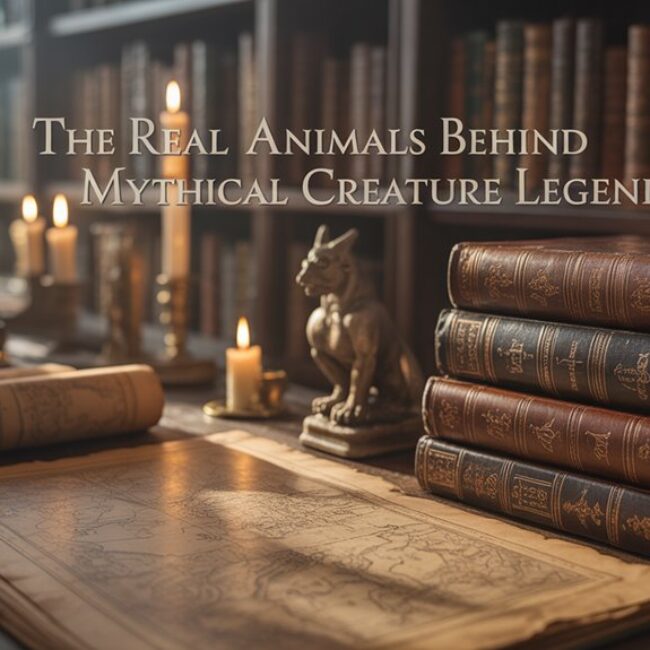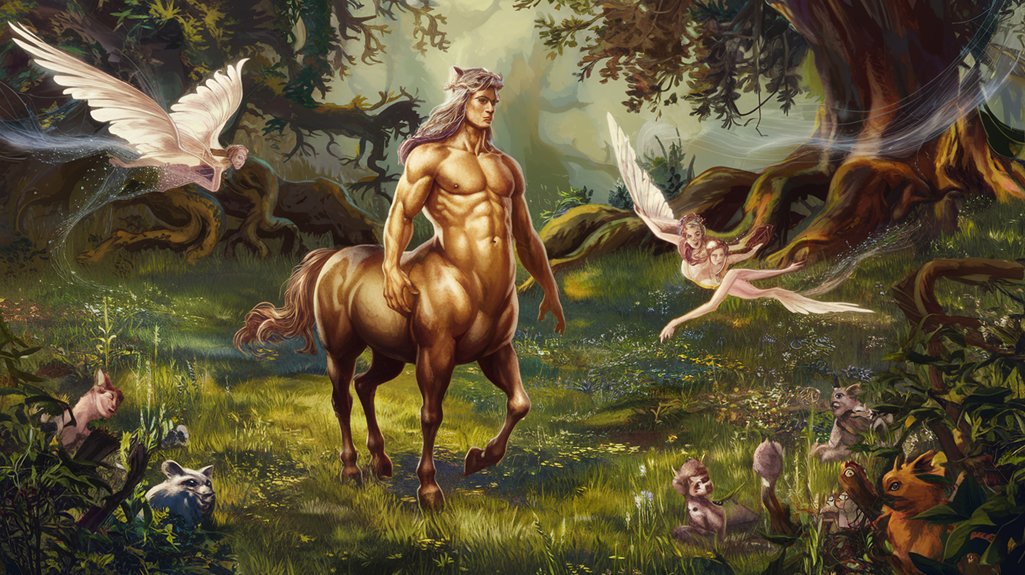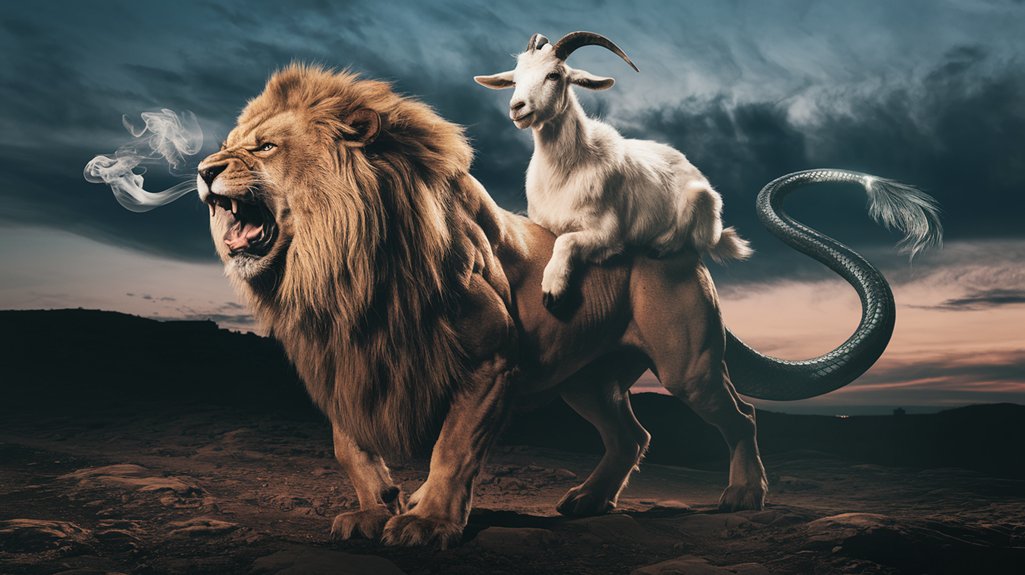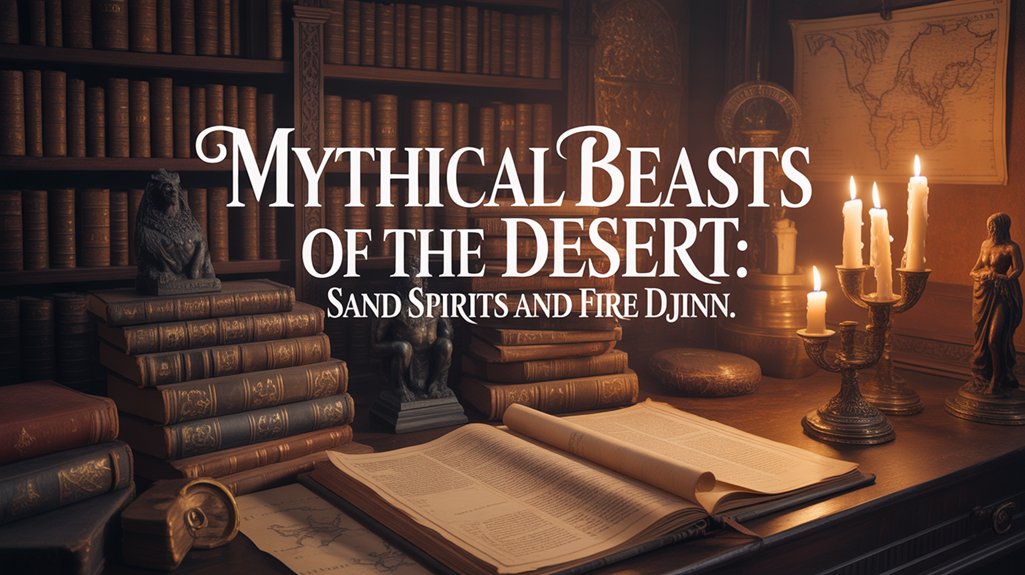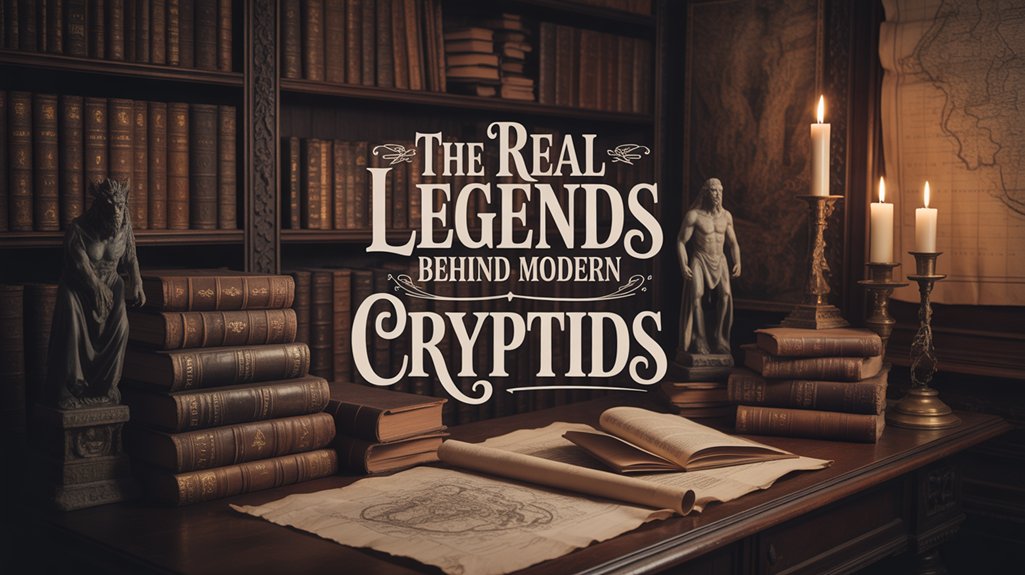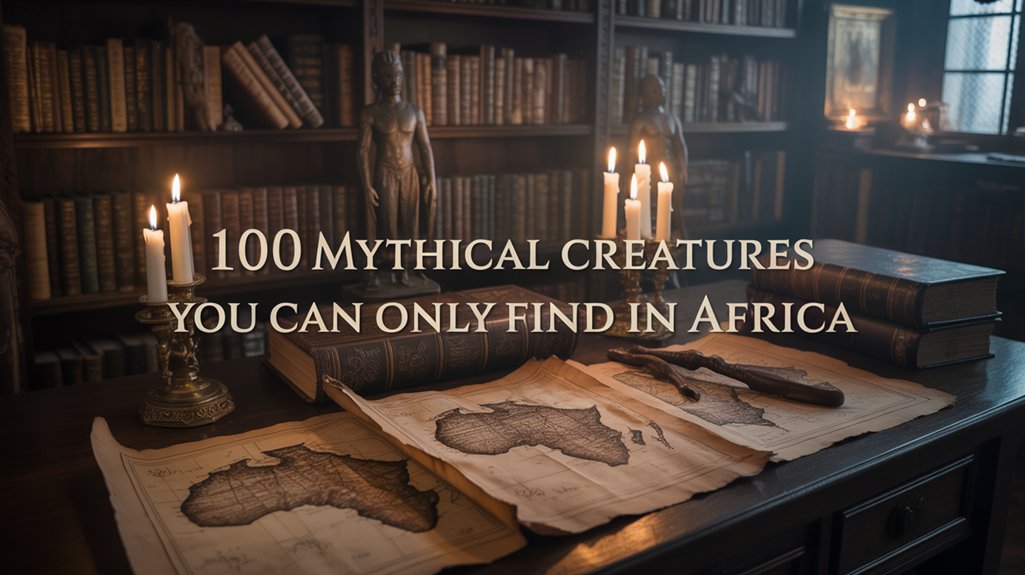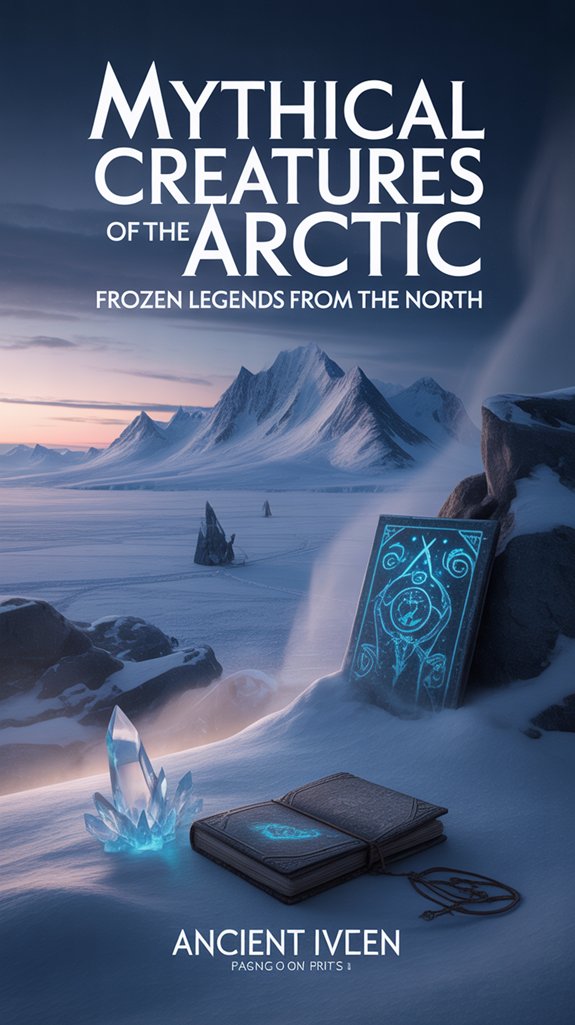
You’ll encounter Arctic mythology as survival codified—where Qalupalik (“the one who lies in wait”) teaches ice safety through Greenlandic terror, and the Amautalik enforces communal bonds by luring isolated children into oblivion. These entities aren’t mere phantasms; they’re mnemonic architectures preserving 4,000 years of Inuit wisdom, altering abstract environmental threats into tangible guardians like Amarok and chimeric predators like Akhlut. Each creature embodies essential knowledge: respect boundaries, maintain vigilance, resist isolation’s seduction. Contemporary safety protocols still integrate these ancestral warnings, recognizing that beneath scholarly taxonomy lies something eldritch—practical philosophy encoded in frozen legend, awaiting those who venture deeper into these primordial narratives.
Table of Contents
ToggleKey Takeaways
- Arctic myths encode survival wisdom through creatures like Mahaha, Wendigo, and Amarok, teaching caution against isolation, greed, and community abandonment.
- Inuit cosmology features three primordial forms: inua spirits within living things, shapeshifters like Ijiraq, and colossal guardians beneath ice.
- Sea monsters Tizheruk and Akhlut symbolize primordial mystery and adaptability, while tundra guardians like Amarok enforce communal bonds.
- Qalupalik and Amautalik serve as cautionary figures teaching children about water safety and the dangers of isolation in Arctic wilderness.
- Modern safety education integrates ancestral warnings with empirical methods, treating folklore as practical knowledge for Arctic survival and ecology.
The Arctic Whispers Ancient Warnings

Before the Arctic winds carved their warnings into ice cliffs and the aurora borealis painted its eldritch luminescence across polar skies, the indigenous peoples of the circumpolar north understood a fundamental truth: the frozen wastes harbored entities that defied natural law.
You’ll find these beings weren’t mere folklore—they were survival lessons encoded in narrative form, transmitted across generations through brutal winters when isolation meant death.
The Mahaha’s deadly tickling, the Wendigo’s cannibalistic hunger, the Amarok’s solitary hunt. Each creature operates as cautionary tales against specific transgressions: wandering alone, succumbing to greed, abandoning communal bonds.
These weren’t entertainment. They were Arctic pedagogy, teaching children and adults alike how psychological dissolution manifests in extreme environments. The Qiqirn’s hairless form reflects internal terror made flesh, while Nanurluk embodies nature’s indifferent power.
These chimeric warnings persist because they address timeless human vulnerabilities. Respect the land. Maintain community. Resist temptation. Survival demands it.
##
You’ll discover that Arctic mythology births its guardians through three primordial forms: the ancient *inua* spirits dwelling within every living thing, the chimeric shapeshifters who blur boundaries between human and beast, and the colossal entities lurking beneath ice-shrouded waters.
These beings—whether terrestrial protectors of the tundra or aquatic leviathans guarding the depths—emerge from a worldview where consciousness permeates stone, sea, and storm alike.
The Inuit cosmology refuses Western taxonomies; instead, it presents a fluid pantheon where guardian and threat, protector and predator, occupy the same liminal space.
Ancient Inuit Spirit Beings
Across the frozen expanse of the Arctic, where glacial winds sculpt ice into otherworldly formations and the aurora borealis illuminates endless nights, the Inuit peoples developed a rich cosmology of spirit beings—entities that emerged not from idle fancy but from profound observations of survival, mortality, and the liminal threshold between the human and the inhuman.
These Inuit Spirits encoded Ancient Legends with visceral warnings: the Mahaha’s eldritch tickling, death disguised as play; the Nanurluk’s primal might, demanding reverence; the Wendigo’s chimeric hunger, cautioning against moral corruption.
The Cultural Symbolism resonates through the Amarok’s communal imperatives and the Ijiraq’s shapeshifting disorientation. Each possesses profound Spiritual Significance, altering environmental hazards into mythic consciousness—teaching you that survival requires acknowledging forces beyond rational comprehension.
Shapeshifters of Frozen Lands
Among the Arctic’s most unsettling spirit entities, shapeshifters emerge as metaphysical expressions of the landscape’s fundamental instability—where whiteout conditions erase horizons, where ice alters hourly between solid ground and lethal fracture, where survival depends on distinguishing caribou from blizzard-born phantoms.
The Ijiraq embodies this eldritch uncertainty, changing into familiar animals, trusted companions, even loved ones to lure you from safe passage.
Shapeshifter symbolism here transcends mere deception—it reflects identity fluidity within cultures where human consciousness interweaves with animal spirits, where boundaries dissolve between flesh and essence.
These chimeric beings demand your vigilance, your respect. They teach that freedom in the Arctic requires acknowledging the wilderness won’t conform to your expectations. Nothing remains fixed. Everything changes.
Like myths across cultures, these Arctic legends serve as fundamental worldviews that explain both natural phenomena and the psychological relationship between communities and their unforgiving environment.
Sea Monster Arctic Legends
Beneath the Arctic’s frozen surface, where light fractures through millennia-old ice into cathedral depths, colossal entities patrol boundaries between elements—shapeshifters not of form alone but of fundamental nature itself.
You’ll encounter the Tizheruk, that elusive serpent whose undulating presence beneath pack ice embodies primordial mystery. Tizheruk symbolism resonates through Inuit cosmology as warning and wonder, reminding you that certain territories demand reverence, not conquest.
The chimeric Akhlut hunts across both domains—wolf upon tundra, orca through brine—demonstrating Akhlut adaptability as sacred principle. These aren’t mere monsters. They’re philosophical statements carved in flesh and fear, teaching indigenous peoples that survival requires fluidity, respect for boundaries both physical and metaphysical.
Even the landlocked Wendigo connects, representing isolation’s terrible cost in environments where community means existence itself.
Tundra Guardians and Protectors
Where tundra extends its wind-scoured vastness beneath perpetual twilight, entities emerge not as threats but as custodians—guardians whose violence serves ecological balance rather than malevolence.
The Amarok embodies this paradigm, a lupine sentinel whose predation targets isolated hunters, enforcing communal bonds essential for Arctic survival.
Tundra spirits manifest through the Ijiraq’s eldritch shapeshifting, deliberately disorienting those who traverse without proper reverence, its chimeric form protecting sacred spaces from careless intrusion.
Even Mahaha’s macabre tickling ritual serves territorial imperative—death becomes enforcement mechanism rather than sadistic pleasure.
Guardian myths preserve ancestral wisdom: these protectors don’t oppose your freedom but demand accountability.
Nanurluk’s colossal presence reinforces boundaries between human ambition and wilderness sovereignty.
The Akhlut bridges domains, demonstrating adaptation’s necessity.
You’re encountering forces maintaining equilibrium, not restricting movement—sovereignty through respect, liberation through understanding.
Inuit Oral Traditions, 4000 BCE

Among the frozen littorals of Baffin Bay, where pack ice fractures beneath unwary feet and tidal currents churn beneath deceptive surfaces, Inuit parents conjured the Qalupalik—an eldritch marine humanoid whose translucent skin, scaled appendages, and moss-draped hair embodied the Arctic Ocean’s lethal capriciousness.
You’ll find this creature embedded within pedagogical narratives transmitted through millennia, its grotesque form designed to snatch disobedient children who ventured too close to thin ice, dragging them beneath frigid waters into an underwater domain from which no return was possible.
These child-snatching stories served as survival instruction cloaked in supernatural dread, altering environmental hazards into chimeric warnings that parents wielded with ancestral authority.
Qalupalik Child-Snatching Stories
While Arctic waters concealed countless dangers for Inuit children dwelling along frozen coastlines circa 4000 BCE, none proved more psychologically potent than the Qalupalik—a humanoid entity characterized by its distinctive green, scaled epidermis and long, claw-tipped fingers capable of snatching unsuspecting youth from ice edges.
You’ll find this eldritch being embedded within oral histories, where Qalupalik encounters served dual purposes: instilling protective parental fears while teaching autonomy through consequence. The creature’s chimeric form—part human, part aquatic predator—embodied the sea’s treacherous nature, altering abstract danger into visceral warning.
Children who ignored boundaries faced abduction into frigid depths, trapped within the creature’s amautik. These narratives weren’t mere entertainment but survival mechanisms, encoding environmental wisdom within psychological frameworks that respected your freedom to choose while understanding consequences demanded respect for nature’s unforgiving power.
Baffin Bay Coastal Waters
The frigid expanse of Baffin Bay—stretching between Greenland’s eastern precipice and Canada’s Arctic archipelago—harbored within its depths a pantheon of entities whose narratives crystallized fundamental truths about existence in humanity’s most unforgiving maritime frontier. Since 4000 BCE, the Inuit connection to these waters manifested through oral traditions preserving eldritch knowledge of survival.
| Entity | Symbolic Function |
|---|---|
| Tizheruk | Maritime mysteries, respect for unknowable depths |
| Mahaha | Deceptive dangers, vigilance against complacency |
| Nanurluk | Untamed wilderness, coexistence with apex predators |
These chimeric beings weren’t mere phantasms—they encoded environmental wisdom. The Mahaha’s tickling death warned against underestimating threats. Nanurluk demanded reverence for nature’s sovereignty. Each creature reinforced communal bonds necessary for Arctic survival, altering Baffin Bay into sacred geography where myth and reality converged.
Parental Warning Against Thin Ice
Across millennia of Arctic habitation, Inuit parents weaponized the Mahaha’s malevolent presence to inscribe survival imperatives into their children’s consciousness—transforming abstract danger into corporeal dread.
This eldritch figure lurked where frozen surfaces thinned, embodying ice safety’s mortal stakes. You’ll find within these oral traditions, transmitted since 4000 BCE, a sophisticated pedagogical framework: parental guidance crystallized through chimeric terror.
Children learned to read crystalline surfaces, distinguishing stable pathways from treacherous zones where the Mahaha waited. The creature’s Tickling Death—freezing victims while inducing involuntary laughter—metaphorized hypothermia’s insidious progression.
Such tales weren’t mere entertainment. They encoded empirical knowledge: temperature fluctuations, current patterns, seasonal shifts. Through generations, this cautionary folklore nurtured hypervigilance, ensuring survival where one misjudgment meant drowning beneath opaque ice.
Freedom demanded respect for Arctic caprice.
Greenlandic Vs Canadian Qalupalik Names

Among Arctic peoples separated by the Davis Strait’s frigid expanse, linguistic variations of the Qalupalik’s name reveal profound insights into how disparate communities conceptualized this eldritch maritime predator.
In Greenlandic folklore, “Qalupalik”—meaning “the one who lies in wait”—captures the creature’s patient, deceptive essence. Canadian Inuit traditions employ regional variations that emphasize different aspects of this chimeric being’s nature.
| Region | Name Variation | Literal Translation |
|---|---|---|
| Greenland | Qalupalik | The one who lies in wait |
| Canadian Arctic | Qaallupilluit | Those who wait beneath |
| Baffin Island | Qallupilluk | The one lurking below |
The nomenclature itself becomes warning. Each syllable whispers ancestral wisdom about respecting boundaries between land and sea, safety and peril. These names aren’t mere labels—they’re crystallized cautions passed through generations, linguistic monuments to children lost, to the sea’s unforgiving depths. The variations demonstrate how independent communities, though separated by geography, converged upon similar truths about childhood vulnerability and maritime danger. Like all mythologies, these Arctic tales reflect the beliefs and values of cultures that created them, addressing fundamental questions about human existence through colorful storytelling.
Thin Ice Represents Life’s Dangers
Beyond nomenclature and cautionary names lies something more primal—Arctic ice itself becomes metaphor, altering physical danger into existential warning.
You’ll find that thin ice represents humanity’s most fundamental vulnerabilities, those hidden dangers lurking beneath deceptively stable surfaces.
These eldritch warnings manifest through:
- The Mahaha’s sinister tickling—transforming seemingly harmless encounters into fatal miscalculations, reminding you that death wears many masks.
- Nanurluk’s colossal presence—embodying nature’s untamed power, where fragile ice sheets become proving grounds for your survival instinct.
- The Wendigo’s consumptive hunger—illustrating how desperation drives souls onto unstable terrain, greed trumping wisdom.
The Amarok teaches collective resilience against isolation’s bite, while the Qiqirn’s hairless form manifests your deepest psychological fractures.
These chimeric beings don’t merely haunt frozen landscapes—they crystallize universal truths.
Each crack beneath your feet echoes life’s precariousness. Freedom demands respect for boundaries, acknowledgment of forces beyond human control.
The Amautalik Kidnapping Account

You must understand that the Amautalik emerges from the frozen reaches of Inuit cosmology as an eldritch guardian of boundaries, its origins intertwined with the practical necessity of teaching children about Arctic survival through supernatural consequence.
This chimeric entity—part cautionary specter, part embodiment of environmental peril—manifests in oral traditions as a soft-bodied giant whose deceptive gentleness masks its abductive intent, luring the unwary into permanent isolation.
The creature’s behavioral patterns reflect the liminal terror of the tundra itself, where modern accounts continue to surface among Arctic communities, suggesting that ancient warnings still resonate through generations as both cultural memory and living practice.
Origins of the Legend
When darkness descends upon the Arctic tundra for months at a time, the Inuit peoples have long understood that survival depends not merely on physical endurance but on the transmission of essential knowledge through narrative—and few legends embody this principle more starkly than the Amautalik kidnapping accounts.
The Amautalik origins trace back centuries through oral tradition, where maternal figures changed into eldritch warnings against the tundra’s chimeric threats. Inuit storytelling employed this snow-shrouded woman as pedagogical device, her deceptive warmth masking predatory intent.
You’ll find these accounts weren’t mere entertainment but survival mechanisms, encoding territorial boundaries and behavioral protocols within mythic frameworks. The legend crystallized around genuine environmental dangers—hypothermia’s seductive numbness, whiteout disorientation, the Arctic’s capacity to swallow wanderers whole.
Knowledge becomes lifeline.
Characteristics and Behavior Patterns
The Amautalik materializes in accounts as a figure of deliberate contradiction—maternal silhouette concealing predatory architecture.
You’ll find its Amautalik characteristics woven through Inuit oral traditions: the chimeric form that dissolves into snowscape, vanishing before witnesses can process its presence.
Its mythological behavior follows calculated patterns—promises of warmth become instruments of abduction, comfort changes into isolation.
Children disappear into desolate territories beyond parental reach.
This eldritch entity embodies the Arctic’s capricious nature, where safety evaporates without warning.
The creature’s methodology speaks to deeper truths about wilderness boundaries and stranger danger, knowledge your ancestors encoded in cautionary narrative.
Through such legends, communities transmitted survival wisdom—teaching children that the frozen north respects neither innocence nor ignorance, only vigilance.
Modern Interpretations and Sightings
Though contemporary accounts remain sparse and fragmented, communities across Nunavut and Greenland’s eastern settlements preserve disturbing testimonies of Amautalik sightings that refuse rational dismissal.
You’ll find these contemporary folklore narratives clustered around unexplained disappearances—children who wandered beyond settlement boundaries, never returning. Elders recount encounters with chimeric figures glimpsed through ice fog, their forms simultaneously maternal and predatory.
Modern interpretations frame the Amautalik as cautionary archetype, warning against wilderness complacency. Yet something deeper persists. These aren’t mere cautionary tales manufactured for obedience. They’re living testimonies reflecting profound environmental wisdom, acknowledging Arctic dangers through mythological lens.
Researchers documenting these accounts encounter consistent details: the creature’s eldritch presence, her territorial nature, the community’s collective memory of loss. She embodies respect for nature’s sovereignty—a truth your ancestors understood instinctively.
Qalupalik in Contemporary Canadian Art

Across galleries and public spaces throughout Canada’s northern reaches, contemporary artists invoke the eldritch presence of the Qalupalik—that ancient abductor of wayward children who lurks beneath ice-rimmed waters—transforming traditional Inuit oral narratives into visceral visual statements that pulse with both ancestral warning and urgent ecological evidence.
Through Qalupalik symbolism, you’ll witness how Indigenous creators weave contemporary storytelling methods with primordial cautionary tales, generating works that transcend mere aesthetic contemplation.
These artistic manifestations serve three critical functions:
- Cultural preservation through visual documentation of oral traditions facing erasure
- Environmental advocacy linking the creature’s aquatic domain to climate-threatened Arctic ecosystems
- Intergenerational dialogue bridging elder knowledge with youth engagement
You’ll find the Qalupalik’s chimeric form—simultaneously monster and guardian—embodying the paradoxical relationship between respect and fear that characterizes Inuit environmental philosophy.
The creature emerges not as folklore relic but as living proof of Indigenous ecological wisdom.
Evolutionary Basis of Parental Fear
When primordial hominids crouched beneath Pleistocene skies, scanning savannah grasses for the telltale ripple of stalking predators, they weren’t merely surviving—they were encoding into their neural architecture an inheritance that would reverberate through millennia, manifesting in the very marrow of parental dread you experience when your child wanders beyond sight.
Your panic when your child disappears isn’t irrational—it’s evolutionary wisdom carved into consciousness by ten thousand generations of predation.
This evolutionary psychology persists, ancient and uncompromising. Your parental instincts carry predation’s memory—the leopard’s amber eyes, resource scarcity’s grinding desperation. These aren’t chimeric fears conjured from imagination’s eldritch depths; they’re survival mechanisms forged in ancestral crucibles, transmitted across generations through vigilant behaviors and heightened threat assessment.
You inherit this vigilance. Watch how your child learns fear through your reactions, absorbing protective strategies refined across evolutionary epochs. The unknown triggers instinctual responses observable across cultures and species alike.
Freedom from danger required these very chains—parental anxiety as adaptive inheritance, binding you to ancestral imperatives while safeguarding tomorrow’s survival.
Modern Arctic Safety Education
That primordial vigilance finds contemporary expression in Arctic safety protocols, where ancestral wariness meets empirical methodology—transform fear into knowledge, instinct into systematic preparation.
Wildlife education channels the Nanurluk’s ferocity into bear awareness protocols, survival skills echo the Wendigo’s starvation warnings through shelter-building competencies.
Navigation techniques combat the Ijiraq’s disorienting essence with GPS technology and traditional wayfinding wisdom merged into chimeric guidance systems.
Community cooperation resurrects Amarok’s pack mentality. No solitary hunters survive these latitudes anymore.
Cultural respect bridges mythological terror and scientific understanding—eldritch creatures weren’t merely campfire phantoms but encoded survival imperatives.
Today’s programs honor indigenous knowledge systems, recognizing that folklore preserved practical warnings across generations before written documentation existed.
The Inuit understood: stories that frightened children kept them alive. Modern curricula maintain this balance, treating ancestral tales as living heritage rather than primitive superstition, acknowledging that every legendary beast represented genuine environmental threats demanding communal vigilance, preparation, reverence.
Myths Preserve Arctic Wisdom
Beyond their spectral terror, Arctic myths function as mnemonic architectures—survival databases encrypted in narrative form, designed to persist through oral transmission when written couldn’t withstand the cold. Each creature embodies essential wisdom: the Wendigo’s mythical symbolism warns against the cannibalistic desperation that isolation breeds, while Nanurluk commands reverence toward nature’s overwhelming might.
The Amarok teaches cooperation as prerequisite for existence. Pure survival pedagogy.
These narratives carried cultural significance far exceeding mere entertainment. They encoded behavioral protocols, psychological warnings, environmental knowledge. The Qiqirn’s eldritch manifestation represents sanity’s fragile membrane in prolonged solitude—a psychiatric diagnosis wrapped in chimeric form.
The Akhlut demonstrates necessary fluidity, adaptability between terrestrial and marine domains, teaching resourcefulness as cardinal virtue. Such stories created mental frameworks that young hunters internalized, altering abstract dangers into tangible entities.
You inherited not superstition but sophisticated knowledge systems, each monster a crystallized lesson in Arctic epistemology. Freedom depended on understanding these frozen warnings.
Frequently Asked Questions
What Other Mythical Creatures Exist in Arctic Folklore Besides Qalupalik?
You’ll encounter the eldritch Tundra Spirits across circumpolar shamanic traditions, ethereal guardians of frozen territories who demand offerings from those traversing their domains.
Scandinavian lore reveals the chimeric Frost Giants, primordial jötnar predating humanity itself, dwelling in Jötunheimr’s glacial wastes.
The Inuit speak of Mahaha, whose rictus grin precedes death by tickling.
Liberation from modern skepticism allows you to glimpse these beings—ancient, unbound entities dwelling in liminal spaces where permafrost meets mythology.
How Do Russian Arctic Myths Compare to Inuit Traditions?
You’ll discover profound differences between Russian Spirits—like the frost-dwelling Ded Moroz and shape-shifting kikimora—and Inuit Legends of altering beings such as tupilaq.
Russian traditions emerged from Slavic paganism, emphasizing hierarchical deities controlling winter’s fury. Inuit cosmology, conversely, centers on animistic reciprocity, where creatures embody natural forces requiring respectful negotiation.
Both systems share reverence for the eldritch Arctic’s power, yet Russians personified winter as conquerable entity, while Inuit recognized humanity’s subordinate position within the frozen cosmos.
Are There Any Benevolent Creatures in Arctic Mythology?
You’ll discover benevolent spirits throughout Arctic cosmologies, guardians who transcend the harsh nihilism outsiders project onto frozen domains.
The Inuit’s *tuunngait* include protective entities, chimeric magical animals that grant shamanic wisdom without constraint.
Sámi traditions honor *haldde*—watchful land spirits offering abundance to those respecting autonomy.
Russian folklore speaks of the *poludnitsa*, eldritch yet nurturing.
These beings represent sovereignty, ancient pacts between humans and nature where reverence, not subjugation, guarantees survival in liminal territories.
What Role Do Auroras Play in Arctic Mythical Stories?
You’ll discover aurora symbolism woven through circumpolar cosmologies as bridges between worlds.
The northern lights manifest ancestral spirits dancing—Sámi traditions speak of departed souls, while Inuit legends warn you against whistling, lest the aurora descend and sever your head.
These eldritch curtains of light serve as portals, battlegrounds of celestial warriors, or reflections from the torches of seal-hunting spirits.
Each flicker contains profound meaning, demanding your respectful silence beneath their chimeric glow.
Do Scandinavian Countries Share Similar Arctic Creature Legends?
You’ll discover profound Scandinavian similarities across Norway, Sweden, and Finland’s Arctic mythology, where shape-shifting stallos, malevolent trolls, and the eldritch *draugr* traverse frozen wastes with unsettling consistency.
These shared legends—rooted in Norse cosmology circa 800-1050 CE—reflect your ancestral freedom to interpret nature’s chimeric forces.
The *huldra*, that forest-dwelling seductress, appears throughout Nordic territories. Regional variations exist, yet core motifs remain: ice, darkness, metamorphosis.
Ancient knowledge transcends modern borders, revealing unified spiritual landscapes.
Conclusion
You’ve traversed the eldritch borderlands where Qalupalik’s humming echoes beneath fractured ice, where the Amautalik’s shadow stretches across millennia. These aren’t merely cautionary tales—they’re cartographies of survival, etched into consciousness through 6,000 winters of accumulated wisdom. When you warn your children about thin ice, you’re channeling ancestral voices, perpetuating chimeric guardians who’ve protected Arctic communities since the Holocene. The myths endure because danger endures. Listen closely. The ice still whispers its ancient warnings, demanding your reverence, your vigilance.




